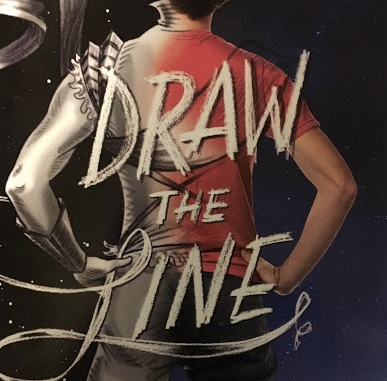
 As part of our ongoing collaboration with the Book House of Stuyvesant Plaza, our writers have accepted the challenge of reading and reviewing pre-publication review copies of highly anticipated young adult literature. The reviews are posted here for our readers, but also will be sent to the Book House where they will hopefully be used to inform customers about the books they may want to purchase.We will try to publish one review a week for the spring.
As part of our ongoing collaboration with the Book House of Stuyvesant Plaza, our writers have accepted the challenge of reading and reviewing pre-publication review copies of highly anticipated young adult literature. The reviews are posted here for our readers, but also will be sent to the Book House where they will hopefully be used to inform customers about the books they may want to purchase.We will try to publish one review a week for the spring.
The reviews contain spoilers, so be forewarned!
Draw the Line
by Laurent Linn
Published May 2016
516 pages, McElderry Books
Draw the Line by Laurent Linn tells the story of a boy by the name of Adrian Piper. After a fight occurring between the local outed gay Drama club dedicatee Kobe and the town bullies resulting in terrible injuries and unjust payback due to the local biases, comic artist and closeted LGBTQ junior Adrian becomes the victim of the bullies’ torment. He had come to the aid of Kobe, and now rumors are spreading that he, too, was gay. All of this is documented in Adrian’s secret website that tells the story of Graphite, his renaissance art-inspired character, where he documents his life from his perspective. Eventually much more happens, but alas, this is a review, not a summary, and going any further would be spoiling the storyline for future readers.
Of course, every book has its good and bad components, even our favorite ones can be critiqued. But this book, in my opinion, had more than its fair share of qualities that I deemed ‘unsuccessful’. The first and most prominent of which being the characterization of our hero, Adrian Piper. Adrian is what some people might go so far as to calling an “introvert.” I would call him a complete social failure. Of course, I understand that the whole point of the book was him overcoming this anxiety, but I found the change to be so sudden, brought on by almost nothing, and anticipated by a particularly hilarious caricature of an Average Teenage Student™. Of course nowadays the glorification of the Nerd character can’t be ignored anymore, everyone can identify with the social outcast, the one who would rather read books than go to a party. Statistically, there is a larger percentage of introverts in the world than extroverts, and this is becoming evident within literature and media. Adrian is a subgenre of the nerd, he is a Loser. The Loser is a character that instead of sitting at the D&D table with the anime watching, inhaler using, math freaks, he is a step above them. Instead, he sits at his high and mighty table with his two other friends, the goth kid and the angry extrovert girl. The Loser character often refuses to communicate with anyone deemed more popular than him, seeming himself as hilariously inferior in every way, his secretly charming personality and moderate good looks overshadowed by his self-consciousness and anxiety issues. I have read many stories making use of the Loser character, making him adorably pitiful yet still relatable to the majority of the population in some way or another. And while I understand the compulsion to a character like the Loser, this archetype has been so overdone that I found Adrian’s character utterly despicable and dull. I was much more interested in the stories of his only other friends, Audrey and Trent. Audrey, who identifies as an overweight black fashionista, is overwhelmingly rife with personality and character quirks that make her motivations and reasoning behind decisions fascinating to follow and decode. Trent, the scary goth kid, behaves nothing like what anyone expects him to, he is witty and charismatic, writing a large and fancy word on his arm every week to incorporate into his daily speech. Had the book been from either of their perspectives, I would have been endlessly entertained. But unfortunately it was told by cookie cutter Loser Adrian Piper.
The second issue I found most prominent would be Adrian’s interest in Renaissance art. I too, have a profound interest in the Renaissance, especially Michelangelo, so I could relate to Adrian’s fascination. My relation changed the second I found out the reason for his interest. It was the anatomy. Specifically the muscular ripped males painted by everyone’s favorite gay artists Leonardo Da Vinci, Michelangelo, and literally every other artist at the time. I found this a tad unnecessary and unrealistic. You would think a comic book artist’s favourite era would be impressionism, due to the rugged gesture and depictions of movement, or perhaps cubism because of the multiple perspectives and new angles. Anatomy seems like the least of a comic book artist’s worries. Of course I don’t draw comics and could never imagine doing something as invigorating and time consuming as that, and I applaud Adrian for being able to study and depict the human body consistently and accurately, and for his brilliant character design of graphite, combining renaissance fashion with a classic superhero outfit. I was very impressed with this. But seriously, anatomy should NOT be any artist’s main focus. It should be a secondary concern at most, only coming out when the drawing is supposed to be realistic. Which comic books, and especially Graphite, are not.
An interest in Renaissance art PRIMARILY because of the anatomy is a massive stretch. Besides, an interest based primarily on physical attractiveness is somewhat of a stereotype for the LGBTQ community that could and should be abolished, as it reduces the entire cause to being all about sex. Renaissance art anatomy hadn’t even been perfected. One glance at the Sistine chapel could tell you that. Speaking of the Sistine chapel, Michelangelo is who Adrian considers his Renaissance boyfriend. Michelangelo wasn’t even hot, and for someone who is only into Renaissance art because of the physical attractiveness, considering Michelangelo to be his boyfriend is laughably inaccurate. Also, Adrian’s “type”, based off of textual evidence, is absolutely nothing like what the real Michelangelo was like. He was an angry, spiteful, paranoid old man, and any self-proclaimed enjoyer of Renaissance art would know that. So either the author didn’t do his research, or Adrian is once again a poorly executed character. “But Sarah,” you may argue, “why should it matter why Adrian is interested in sexy renaissance men?” To which I would reply that his interest was terribly informed and poorly executed, and didn’t mesh well with the character at all. “But Sarah,” you argue back, “maybe his interest wasn’t primarily based on the sexy Renaissance men, it could be based on art techniques of the time that he admired or various other factors!” Yes, you’re correct, it could have been. But nothing of the sort was actually stated or even implied within the canon of the text, and thus it is a safe assumption that his only reason for interest was based off of physical attractiveness.
There were good things, of course. The overall plot was easily followed and contained enough twists to keep me interested, and made me stay up far past my self-inflicted bedtime to get further into it. Many of the characters’ intentions were completely unexpected but had massive foreshadowing when thought about, which lead to a mental case file of who was doing what, and made certain parts seem like a whodunit, with surprises around every corner. And the addition of actual pages from the comic book, showcasing the adventures of Graphite were a creative and generous touch of realism that allowed the book to encompass a certain finesse that also helped to engage me. However, I despised Adrian’s characterization so much that I just can’t say I enjoyed the book. Now it could just be that I’m a few years above the intended age audience, and that I’ve grown out of the awkward phase where everyone considers themselves to be jaded teens when in actuality they’re just scared and self-conscious. For anyone ages 12-14, I’d say this is an ideal book to read, especially for those who are going through phases of self-discovery and need a few book characters that tell them that everything is ok. However, for anyone like me who craves a storyline with depth, with 100% engaging characters, and perhaps historically accurate depictions of the Renaissance, this book would drift under the radar usually. As for me, I’ll likely forget that I ever read it within the year, as I’ve read many more memorable books for this intended audience.
